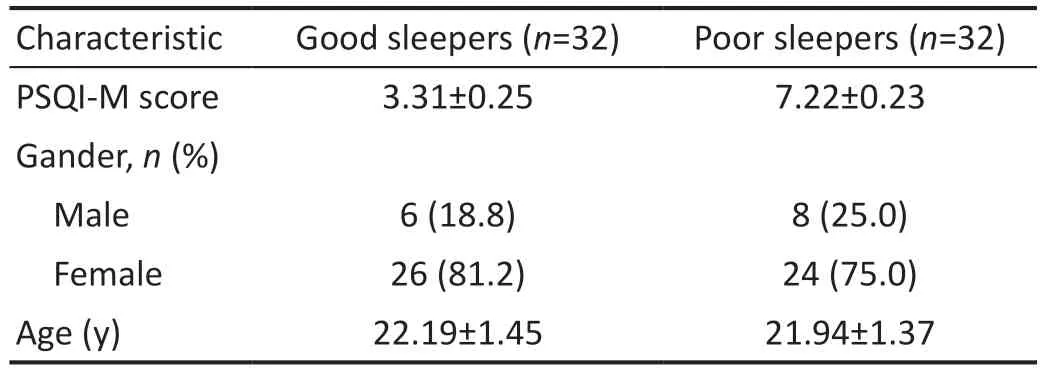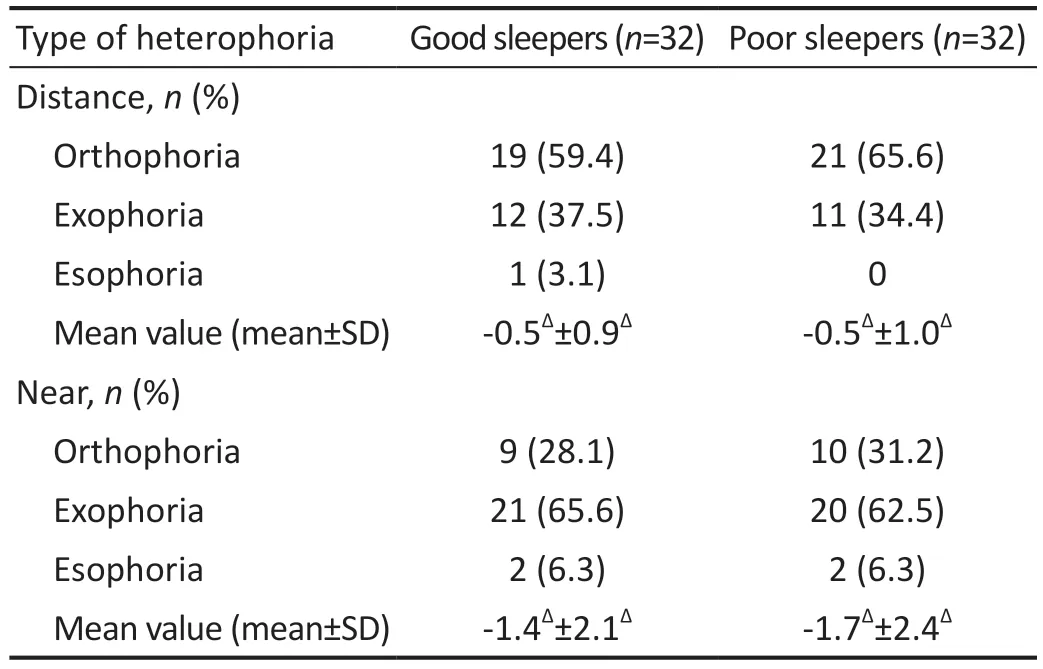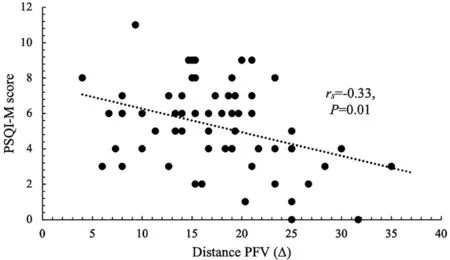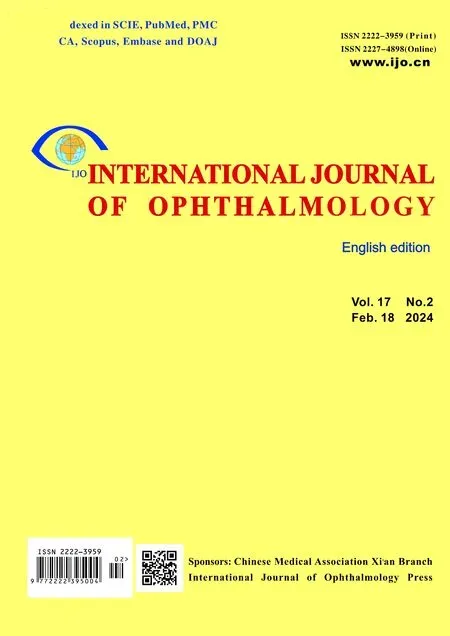Comparison of vergence mechanisms between university students with good and poor sleep quality
Pui Juan Woi, Joyce Yi Ling Lu, Mohd Izzuddin Hairol, Wan Nur Amirah Ibrahim
1Optometry and Vision Science Programme, Center for Community Health Studies (ReaCH), Faculty of Health Sciences, Universiti Kebangsaan Malaysia, Kuala Lumpur 50300, Malaysia
2Centre of Optometry Studies, Faculty of Health Sciences,Universiti Teknologi MARA, Selangor Branch, Puncak Alam Campus, Selangor 42300, Malaysia
Abstract
● KEYWORDS: binocular vision; vergence; sleep quality;university students
INTRODUCTION
University students nowadays have to cope with numerous challenges such as academic pressures,social obligations, internet distraction, being responsible for themselves, and erratic schedules.These challenges faced by university students are associated with sleep disturbances which lead to poor sleep quality[1-3].A Meta-analysis of sleep quality in university students from the medical field reveals that Europe has the highest prevalence of poor sleep quality in university students (65.1%), follow by Americas (59.9%),Africa (54.5%), Asia (47.4%) and Oceania (30.5%)[4].
Consistent lack of sleep or reduced sleep quality can affect binocular vision function[5-8].The study done by Tonget al[5]reported a degradation in stability of both binocular coordination and gaze-target synchronization after 26h of sleep deprivation.Behnke[6]also found a reduction in convergence ability, but accommodative ability remained normal after 24h of sleep deprivation.However, little is known about the effect of sleep quality rather than sleep deprivation induced by sustaining wakefulness, on binocular vision function.
Binocular vergence is the simultaneous movement of both eyes in opposing directions, which is one of the key mechanisms for normal binocular single vision.Fusional vergences are the result of a motor response to a sensory stimulus brought on by the images of the object of regard drifting off one fovea,causing disparity and a subsequent corrective movement of both eyes to maintain fusion and prevent diplopia[9].Heterophoria is the locus of intersection or deviation of the visual axes, measured with respect to the object of regard,in the absence of a fusional vergence response[10].Vergence system anomalies, which are one of the binocular vision anomalies, occur when the fusional vergence values are too low to compensate for the heterophoria.A wide range of ocularsymptoms can result from vergence system anomalies such as blurry vision, diplopia, headache, and difficulty focusing[11].
Binocular vision anomalies reduce visual system efficiency and cause visual symptoms, especially when performing tasks requiring near vision[12].Binocular vision stability is essential for university students to have comfortable vision when reading and learning, but binocular vision anomalies are prevalent among university students[13-14].Therefore, it is crucial to investigate the factors that may be associated with binocular vision stability in university students to foster satisfactory visual performance.The fact that poor sleep quality and binocular vision anomalies are common in university students leads to the question of whether they are related.This study aimed to study the differences in vergence mechanisms at distance and near between good and poor sleepers in university students.
SUBJECTS AND METHODS
Ethical ApprovalThis study was approved by the Research Ethics Committee of the National University of Malaysia(UKM PPI/111/8/JEP-2021-061) and conformed to the tenets of the Declaration of Helsinki involving human participants.All participants signed an informed consent form prior to taking part in the study.
SubjectsA total of 32 good sleepers (mean age 22.19±1.45y)and 32 poor sleepers (mean age 21.94±1.37y) ranging from 19 to 25y were recruitedviapurposive sampling method from the university student population at the National University of Malaysia in this cross-sectional study.The sample size was determined using G*Power 3.1[15]with an effect size of 0.3 and a power of 0.8 at the 0.05 alpha level.The subjects were chosen based on the following inclusion criteria: 1)actively enrolled students, 2) visual acuity of 6/6 or better in each eye with best refractive correction.The exclusion criteria were students with 1) vertical heterophoria, 2) tropia,3) ocular diseases, 4) systemic diseases or medication with known ocular involvement, 5) history of ocular treatment including patching therapy for amblyopia.All subjects underwent a comprehensive ocular health examination to ensure the inclusion and exclusion criteria were fulfilled.All subjects wore their best refractive correction throughout the procedures.
Sleep Quality MeasurementSleep quality was measured using the validated Malay version of Pittsburgh Sleep Quality Index (PSQI-M) questionnaire (internal consistency,Cronbach’s alpha=0.74)[16].The PSQI-M was used to measure self-reported sleep quality and sleep disturbance that occurred in the past month.It consists of 19 individual items that can be divided into seven score components which are sleep quality,sleep latency, sleep duration, sleep efficiency, sleep disturbance,sleep medication, and daily dysfunction (Table 1).The total score from each component gives a global score ranging from 0 to 21.Lower global PSQI-M score indicates good sleep quality while high PSQI-M indicates poor sleep quality.Subjects with a global score greater than 5 are categorized as poor sleepers, while those with a score less than or equal to 5 are categorized as good sleepers.
Heterophoria MeasurementDistance and near Howell cards(Bernell Corp, South Bend, IN, USA) were used to measure heterophoria in this study.The Howell Card heterophoria measurement provides excellent repeatable and reproducible results[17].The tests were conducted at 3 m and 33 cm for measurement of distance and near heterophorias by an examiner.The 6Δbase-down loose prism was placed in front of the right eye to produce vertical diplopia so that 2 number scales and 2 arrows would be observed by the subjects.Then,subjects were asked to report which number the top arrow pointed to on the lower chart image.Odd numbers on yellow colour side (to the right of the centre “0”) represented an esophoria while even numbers on blue colour side (to the left of the centre “0”) represented an exophoria.The heterophoria values were recorded in prism dioptres (Δ).Esophoria was recorded in positive value while exophoria was recorded in negative value.
Fusional Vergence MeasurementPositive fusional vergence(PFV) and negative fusional vergences (NFV) were measured at distance (6 m) and near (40 cm) using the step vergence method with a prism bar.The test targets were single Snellen letters of a size equal to the participants’ visual acuity at distance and near.The step vergence method allows the presence of peripheral cues which represents a more natural environment for measurement[18].The convergence responses stimulated during the base-out measurements may produce vergence adaptation that temporarily bias the subsequent basein values or divergence responses[19].To avoid this vergence adaptation, NFV was measured using base-in prism first then followed by PFV measurement with base-out prism.The break values of NFV and PFV at distance and near were determined and recorded in prism dioptres (Δ).NFV was recorded in negative value while PFV was recorded in positive value.All clinical measurements were conducted in the morning by one examiner to avoid examiner bias.
Statistical AnalysisThe statistical analysis was performed using Statistical Package for Social Sciencesversion 25.0(IBM Corp, Armonk, NY, USA).Non-parametric tests were used to analyse the fusional vergences, which were noncontinuous data due to unequal prism step sizes in prism bar[20].The distance and near heterophorias were not normally distributed by testing with Shapiro-Wilk test and skewness.Mann-WhitneyUtest was used to compare heterophoria,NFV, and PFV at distance and near between good and poor sleepers.Spearman correlation analysis was used to study the relationship between PSQI-M score and PFV at distance.The statistical level ofP<0.05 was considered significant.
RESULTS
Table 2 provides the summary of subjects’ characteristics.Poor sleepers had a mean PSQI-M score that was more thantwice as high as good sleepers.Table 3 shows the distribution of heterophoria types at distance and near.The majority of good (59.4%) and poor sleepers (65.6%) had orthophoria at distance.The range of distance heterophoria in good sleepers was 1.0Δesophoria to -3.0Δexophoria while the range in poor sleepers was orthophoria to -4.0Δexophoria.For near heterophoria, the majority of good (65.6%) and poor sleepers(62.5%) had exophoria.The range of near heterophoria in good sleepers was 4.0Δesophoria to -6.0Δexophoria while the range in poor sleepers was 2.0Δesophoria to -7.0Δexophoria.The mean distance and near heterophoria values were not differ significantly between good and poor sleepers (U=507.5,z=-0.07,P=0.94 for distance;U=511.5,z=-0.01,P=0.99 for near).Both good and poor sleepers exhibited an exophoric shift with decreasing viewing distance.

Table 2 Characteristics of participants mean±SD

Table 3 Distribution of distance and near heterophoria types at distance and near between good and poor sleepers
All measured fusional vergences in both good and poor sleepers fell within normal ranges.The values of distance NFV,near NFV, and near PFV were higher in good sleepers than poor sleepers, but they were not statistically different (Table 4).A statistical difference was found in distance PFV (U=318.0,z=-2.61,P=0.01).The distance PFV of good sleepers was significantly higher than that of poor sleepers by 4.3Δ.A negative statistically significant correlation was found between PSQI-M score and distance PFV,rs=-0.33,P=0.01, revealing that the higher the PSQI-M score which indicates poorer sleep quality, the lower the distance PFV value (Figure 1).

Figure 1 Correlation between PSQI-M score and distance PFV PSQI-M: Malay version of the Pittsburgh Sleep Quality Index questionnaire; PFV: Positive fusional vergence.
DISCUSSION
This study contributes to the understanding of the difference in vergence mechanisms between different sleep qualities in university students.We assessed the vergence mechanisms by means of parameters such as heterophorias at distance and near and horizontal fusional vergences (PFV and NFV)at distance and near.Both distance and near heterophorias showed no statistically significant difference between good and poor sleepers.Sleep quality was also showed no significant effect on distance and near fusional vergences except on distance PFV.Distance PFV showed a greater reduction in poor sleepers and the correlation was statistically significant.Nevertheless, all heterophoria values and fusional vergences among good and poor sleepers fell within the clinically normal range.
Subjects with poor sleep quality were found to have lower distance PFV in this study.Prism fusion range or vergence amplitude measures the tendency of an individual to maintain fusion in the presence of gradually increasing vergence demands[21].PFV is the ability of the eyes to maintain fusion when the convergence demand increases slowly while accommodative demand remains constant.This study suggests that poor sleep quality is correlated with lower distance PFV, which declines the convergence ability at distance.Quant[7]discovered a reduction in the ability to converge the eyes for fusion after 48h of sleep deprivation but the other visual performances including convergence at near remained clinically normal in adults.Another previous study also found a reduction in the ability to maintain binocular convergence at near and distance after 24h of sleep deprivation[8].Our findings are consistent with their outcomes at distance, in spite of the subjects in both previous studies sustained wakefulness to achieve sleep deprivation, while our study measured the sleep quality in the past month.
Inadequate amount of sleep, one of the major causes of poor sleep quality, has a significant impact on arousal[22]and low arousal tends to reduce the regulation of oculomotor control[23].This can degrade the stability of binocular coordination and may cause visual stress on the binocular visual system[5].A sufficient amount of fusional vergence is required to compensate for heterophoria in order to maintain normal binocular vision.Otherwise, individuals may experience visual discomfort due to binocular vision anomalies.Despite the fact that none of the subjects in this study had divergence excess,reduced distance PFV could be one of the clinical indicators of divergence excess.A low distance PFV may not be able to compensate for the exophoric deviation, causing difficulty in maintaining fusion at distance.As a result, individuals may experience visual symptoms like photophobia, diplopia, oneeye closure or reading difficulty[24].
The outcome of this study suggests that poor sleep quality has a negative impact on rectus muscle’s ability to maintain fusion when the convergence demand increases.However,this detrimental effect only manifested in the distance PFV in this study.The near PFV of poor sleepers was lower than that of good sleepers, but the difference was not statistically significant.The possible explanation of these results is that the accommodation system involved in the near tasks under binocular vision contributes to an improvement for near PFV.The process of the accommodation system is tightly linked with the convergence system in near-related vision tasks, where any changes in accommodation will affect convergence, and vice versa.The accommodative convergence induced during near measurement enhances PFV.This study’s findings suggest that muscle fatigue caused by poor sleep quality[25-26]affects the vergence system which is regulated by rectus muscle (skeletal muscle), but not the accommodation system which is regulated by ciliary muscle (smooth muscle).In comparison to skeletal muscle, smooth muscle exhibits less adenosine triphosphatase activity, which can maintain tension for a longer period with lower energy consumption[27], making it less susceptible to muscle fatigue.
Higher PFV is often associated with lower NFV due to the opposite vergence movement mechanisms.In this study, even when good sleepers had higher distance PFV, the distance NFV of poor sleepers remained lower than that of good sleepers.Nonetheless, the fusional vergences of poor sleepers were still clinically normal in this study even though it was lower compared to that of good sleepers.Patients are assumed to be most likely asymptomatic with regard to control of the heterophoria if their fusional vergence measurements fall within clinical normal ranges.However, it is common to have patients with low but clinically normal fusional vergence who are symptomatic in a clinical setting[28].From a clinical standpoint, the cause of low fusional vergence should be identified and management should be given to alleviate their symptoms.
The majority of the subjects in this study had orthophoria at distance and exophoria at near.This finding is similar to the study done by Wajuihian[29], who reported that orthophoria is the most prevalent at distance while exophoria at near among high school students.The heterophoria tends to have an exophoric shift with decreasing viewing distance[30].The development of near exophoria may be an adaptive mechanism to near-point stress but may cause visual symptoms if the exophoria is too large to be compensated for[31].
There are potential limitations to this study.First, this was a naturalistic study; we did not control the amount of sleeping hours.This study may be limited by the fact that the causes of poor sleep quality are different among poor sleepers.Thus,the fatigue experienced by poor sleepers may not necessarily be muscle fatigue but possibly mental fatigue.A further assessment of subjects’ mental health status could be useful to rule out the possibility of mental fatigue.However, mentalrelated issues such as anxiety, depression, and stress are commonly present among university students nowadays[32].It could be difficult to segregate these factors from a university student.Second, the study findings occurred for a particular university student population (clinical and health sciences)at the study site.Future studies will need to examine the generalizability of these findings to other types of student populations.Third, this study did not investigate the vergencerelated symptoms of subjects.Future studies should include the self-reported symptoms to look into the necessity and urgency of management.
The findings of this study could contribute to a better understanding of the relationship between sleep quality and vergence mechanisms in a population of university students.Low fusional vergences is a sign of anomalies in the vergence system, which can cause visual discomfort and negatively impact the academic performance of students[33].Therefore,in order to effectively manage vergence system anomalies,practitioners could find it useful to pinpoint their root causes such as sleep deprivation or sleep disturbance.Further investigation focused on the sleep quality and vergence mechanisms in people with older age would be of interest.Reduction in the accommodation system may have a greater effect on the vergence mechanisms when there is an influence of poor sleep quality.
In conclusion, the present study reveals that distance and near heterophoria do not differ between good and poor sleepers,but the distance PFV does.Sleep quality and distance PFV are significantly correlated, that is, the poorer the sleep quality, the lower the distance PFV.Our findings suggest that university students with poor sleep quality have a reduced ability to maintain fusion with increasing convergence demand at distance.The assessment of sleep quality is recommended for management of vergence system anomalies to ensure the underlying cause is alleviated.Further research into the impact of poor sleep quality on binocular vision stability is warranted in light of our findings.
ACKNOWLEDGEMENTS
The authors wish to thank all the participants for their contribution to this study.
Authors’ contributions:Woi PJ: Conceptualization,investigation, methodology, data curation, formal analysis,writing-original draft, writing-review & editing; Lu JYL:Project administration, conceptualization, investigation,methodology, data curation, formal analysis, writing-original draft, writing-review & editing; Hairol MI: Conceptualization,methodology, writing-review & editing; Ibrahim WNA:Writing-review & editing.
Conflicts of Interest: Woi PJ,None;Lu JYL,None;Hairol MI,None;Ibrahim WNA,None.
 International Journal of Ophthalmology2024年2期
International Journal of Ophthalmology2024年2期
- International Journal of Ophthalmology的其它文章
- RDH12-associated retinal degeneration caused by a homozygous pathogenic variant of 146C>T and literature review
- Intravitreal injection of conbercept for diabetic macular edema complicated with diabetic nephropathy
- Glaucoma drainage device implantation and cyclophotocoagulation in the management of refractory glaucoma after Descemet-stripping automated endothelial keratoplasty
- A highly sensitive fluorescent probe RN-NA reveals peroxynitrite as a novel biomarker for primary open angle glaucoma
- OCTA characteristics in non-arteritic central retinal artery occlusion and correlation with visual acuity
- Ocular decompression retinopathy after phacoemulsification in a patient with primary acute angleclosure glaucoma undergoing chemotherapy
